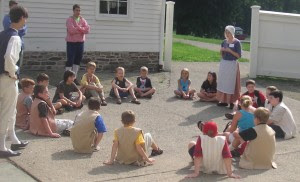It's not official yet, of course, but once the temps get into the 80s, it's summer to me. Time to start complaining about heat and humidity! With the school year just about to end in most places (depending on your snow day situation), I'm a little behind on highlighting summer camp opportunities on the Trails of History. Some are already fully booked, but there are still plenty of chances for parents and caregivers to
get a little break sign their young folk up for fun and learning. This list is not an exhaustive list of programming on the Trails this summer; watch for the monthly program listings for the full calendar (
June listing is here).
A colleague recently shared a note from a reenactor. The reenactor is also a history instructor at a major university and chalks that up, at least in part, to educational programs and museum visits at the
PA Military Museum during his grade school years. "When considering my own story, I strongly encourage educators to work their way through the red tape and finances of arranging field trips for their pupils. The hassle is worth the end benefits. The power of place evokes meaning and connection to young people in dramatic ways. At least it did for me." School field trips are getting fewer and farther between, at least in some districts, but summer history camps and other programs are great ways to nurture a love of history, keep kids active, foster a little (well-supervised) independence, and fight the dreaded "
summer learning loss." So, let's get out there!
Anthracite Heritage Museum, Children's Summer Camp, July 14-17 (
photos from past years). For ages 7-12. Fee charged. Call the museum at 570/963-4804 for more information.
Brandywine Battlefield, Summer History Camp, weekly sessions - June 22-26 through Aug. 3-7, ages vary by week. Week 6 (July 27-31) is fully booked, and Week 3 (July 6-10) is filling up fast. Members receive a discount on registration. Brandywine also offers (subject to enrollment) an extended day option for campers at an additional charge. (
Registration and info.)
 |
| Learning about colonial life at Daniel Boone Homestead |
Daniel Boone Homestead, History Day Camp, July 13-17 - this week-long program features a different theme each day. Members receive a discount. (
Registration brochure and info.)
Drake Well Museum, "
It's All About Oil" Camp, July 13-17 - for children entering grades 4-6. Hands on activities teach about life on an oil lease.
More info here.
Ephrata Cloister, Colonial Summer Camp, July 14-17 or August 11-14 - for ages 6-12 (6-8 and 9-12 will be in different groups).
Explore life at historic Ephrata Cloister through individual and team projects, including arts and crafts, music, and role playing. Members receive a discount. (
More info.) Please register by July 3 (
online registration through Eventbrite, in-person, or by phone at 717/733-6600.)
Ephrata Cloister is also part of this summer's GoEphrata letterboxing initiative sponsored by Ephrata Public Library and Wellspan Health. Wooden posts with metal "autographs" have been set up around the area (including two at Ephrata Cloister) to encourage families to get outside and explore this summer. Booklets and sheets for making rubbings of the autographs can be picked up at the library or
downloaded from GoEphrata.org. Prizes are awarded for participation; the program kicked off on May 30 and is gaining popularity very quickly.
 |
| History camp at Joseph Priestley House |
Joseph Priestley House, History Camp, July 22-24 - for children in grades 1-6. This year's theme is "Priestley House Childhood Memories." (
More info here). Space is limited; enroll by July 20.
Landis Valley Village & Farm Museum, Historic Trades Camp, July 14-17 - designed for older kids (age 12-17), this year's theme is "Journey to America." (Please note that Summer Sampler Camp is full.) Members receive a discount. (
More info.)
Old Economy Village, Happy Ways of Olden Days (Learning 19th-century Life through a Child's Eyes), July 20-24 or July 27-31 - for ages 6-12. Hands-on activities, art projects, music, and more. (
Registration form and info.) Members receive a discount. Registration deadline is July 1.
Pennsbury Manor, Colonial Camp I & II, July 13-17 or July 27-31; Time Travelers Camp, July 22-26 - Colonial Camp is for children who have completed grades 1-4, Time Travelers is for grades 5-7. Family-level members receive a discount. (
Program brochure and registration form.)
 |
| Boot Camp for Kids platoon, 2014 |
PA Military Museum, Boot Camp for Kids, August 1 - for boys and girls ages 8 to 13 and taught by military veterans (
photos from last year). Registration is required by July 24 (
form and info); museum members receive a discount.
Railroad Museum of PA, Barons & Builders Day Camp, July 13-17 - at last check there were still slots available for this session, designed for 9 and 10 year olds (the session for the 11-12 set is already full). Don't wait, register now! (
More info and registration form.)
Somerset Historical Center, History Day Camp, 4 one-day sessions - Jun. 29, Jul. 13 & 27, Aug. 10 - each day will have a different theme. Discount for members and/or if you sign up for all 4 days. (
More info.)
The State Museum of Pennsylvania, Our Solar System Summer Day Camp, 3 sessions - July 7, 14, or 21. For ages 9-12. Explore the Earth's solar system through hands-on activities and planetarium visits. Pick the day that suits your schedule. (
More info.) Members receive a discount.















